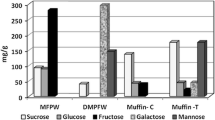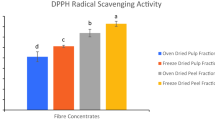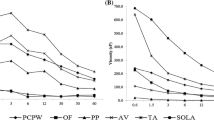Abstract
A comparative study was done on the health promoting and functional properties of the fibers obtained as by-products from six fruits viz., pomace of carambola (Averrhoa carambola L.) and pineapple (Ananas comosus L. Merr), peels of watermelon (Citrullus lanatus), Burmese grape (Baccurea sapida Muell. Arg) and Khasi mandarin orange (Citrus reticulata Blanco), and blossom of seeded banana (Musa balbisiana, ABB). Highest yield of fiber was obtained from Burmese grape peel (BGPL, 79.94 ± 0.41 g/100 g) and seeded banana blossom (BB 77.18 ± 0.20 g/100 g). The total dietary fiber content (TDF) was highest in fiber fraction derived from pineapple pomace (PNPM, 79.76 ± 0.42 g/100 g) and BGPL (67.27 ± 0.39 g/100 g). All the samples contained insoluble dietary fiber as the major fiber fraction. The fiber samples showed good water holding, oil holding and swelling capacities. The fiber samples exhibited antioxidant activity. All the samples showed good results for glucose adsorption, amylase activity inhibition, glucose diffusion rate and glucose diffusion reduction rate index.


Similar content being viewed by others
References
Ajila CM, Aalami M, Leelavathi K, Rao UJSP (2010) Mango peel powder: a potential source of antioxidant and dietary fiber in macaroni preparations. Innov Food Sci Emerg Technol 11:219–224
AOAC (1995) Official methods of analysis, 16th edn. Association of Official Analytical Chemists, Washington, DC
Benzie IFF, Strain JJ (1996) The ferric reducing ability of plasma (FRAP) as a measure of “antioxidant power” the FRAP assay. Anal Biochem 239:70–76
Brand-Williams W, Cuvelier ME, Berset C (1995) Use of a free radical method to evaluate antioxidant activity. LWT Food Sci Technol 28:25–30
Buttriss JL, Stokes CS (2008) Dietary fiber and health: an overview. Nutr Bull 33:186–200
Chang CC, Yang MH, Wen HM, Chern JC (2002) Estimation of total flavonoid content in propolis by two complementary colourimetric methods. J Food Drug Anal 10:178–182
Chau CF, Huang YL, Lee MH (2003) In vitro hypoglycemic effects of different insoluble fiber-rich fractions prepared from the peel of Citrus Sinensis L. cv. Liucheng. J Agric Food Chem 51:6623–6626
Davidson MH, McDonald A (1998) Fiber: forms and functions. Nutr Res 18:617–624
Dhingra D, Mona M, Rajput H, Patil RT (2012) Dietary fiber in foods: a review. J Food Sci Technol 49:255–266
Dinis TCP, Madeira VMC, Almeida LM (1994) Action of phenolic derivates (acetoaminophen, salycilate, and 5-aminosalycilate) as inhibitors of membrane lipid peroxidation and as peroxyl radical scavengers. Arch Biochem Biophys 315:161–169
Evans P, Halliwell B (2001) Micronutrients: oxidant/antioxidant status. Br J Nutr 85:67–74
Fernandez-Gines JM, Fernandez-Lopez J, Sayas-Barbera E, Sendra E, Pérez-Alvarez JA (2003) Effect of storage conditions on quality characteristics of bologna sausages made with citrus fiber. J Food Sci 68:710–714
Gourgue CMP, Champ MMJ, Lozano Y, Delort-Laval J (1992) Dietary fiber from mango byproducts: characterization and hypoglycemic effects determined by in vitro methods. J Agric Food Chem 40:1864–1868
Kahlon TS, Chow FI (2000) In vitro binding of bile acids by rice bran, oat bran, wheat bran and corn bran. Cereal Chem 77:518–521
Lin MJY, Humbert ES, Sosulki FW (1974) Certain functional properties of sunflower meal products. J Food Sci 39:368–370
Lopez G, Ros G, Rincon F, Periago MJ, Martınez MC, Ortuno J (1996) Relationship between physical and hydration properties of soluble and insoluble fiber of artichoke. J Agric Food Chem 44:2773–2778
Naczk M, Shahidi F (2006) Phenolics in cereals, fruits and vegetables: occurrence, extraction and analysis. J Pharm Biomed Anal 41:1523–1542
Nishimune T, Yakushiji T, Sumimoto T, Taguchi S, Konishi Y, Nakahara S, Ichikawa T, Kunita N (1991) Glycemic response and fiber content of some foods. Am J Clin Nutr 54:414–419
Ou S, Kwok KC, Li Y, Fu L (2001) In vitro study of possible role of dietary fiber in lowering postprandial serum glucose. J Agric Food Chem 49:1026–1029
Perez-Jimenez J, Saura-Calixto F (2008) Grape products and cardiovascular disease risk factors. Nutr Res Rev 21:158–173
Robertson JA, de Monredon FD, Dysseler P, Guillon F, Amado R, Thibault JF (2000) Hydration properties of dietary fiber and resistant starch: a European collaborative study. LWT Food Sci Technol 33:72–79
Rubilar M, Pinelo M, Shene C, Sineiro J, Nunez MJ (2007) Separation and HPLC-MS identification of phenolic antioxidants from agricultural residues: almond hulls and grape pomace. J Agric Food Chem 55:10101–10109
Saikia S, Mahnot NK, Mahanta CL (2015) Optimization of phenolic extraction from Averrhoa carambola pomace by response surface methodology and its microencapsulation by spray and freeze drying. Food Chem 171:144–152. doi:10.1016/j.foodchem.2014.08.064
Saura-Calixto F, Goñi I (2006) Antioxidant capacity of the Spanish Mediterranean diet. Food Chem 94:442–447
Schieber A, Stintzing FC, Carle R (2001) Byproducts of plant food processing as a source of functional compounds – recent developments. Trends Food Sci Technol 12:401–413
Slinkard S, Singleton VL (1977) Total phenol analysis: automation and comparison with manual methods. Am J Enol Vitic 28:49–55
Thibault JF, Lahaye M, Guillon F (1992) Physiochemical properties of food plant cell walls. In: Schweizer E, Edwards C (eds) Dietary fiber, a component of food. Nutritional function in health and disease, ILSI Europe. Springer-verlag, Berlin, pp. 21–39
Acknowledgments
One of us (SS) is very grateful to the Council of Scientific & Industrial Research (CSIR), New Delhi, India for providing the Senior Research Fellowship.
Author information
Authors and Affiliations
Corresponding author
Rights and permissions
About this article
Cite this article
Saikia, S., Mahanta, C.L. In vitro physicochemical, phytochemical and functional properties of fiber rich fractions derived from by-products of six fruits. J Food Sci Technol 53, 1496–1504 (2016). https://doi.org/10.1007/s13197-015-2120-9
Revised:
Accepted:
Published:
Issue Date:
DOI: https://doi.org/10.1007/s13197-015-2120-9




